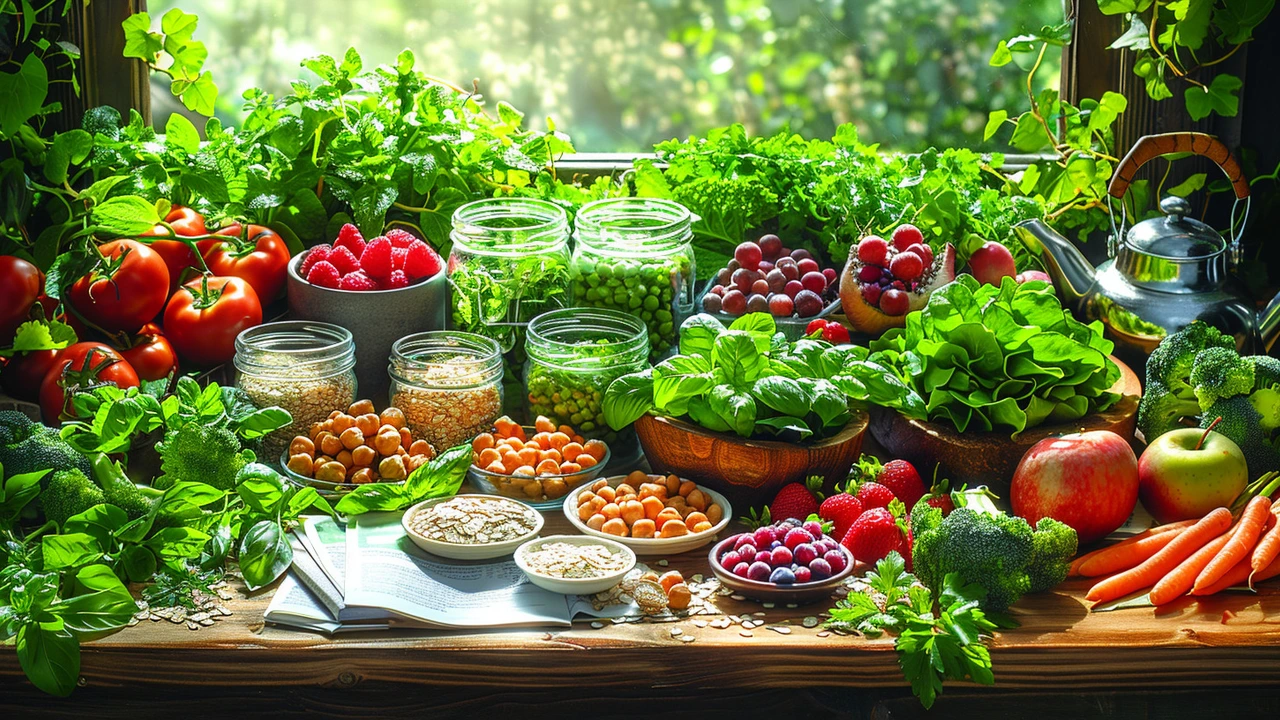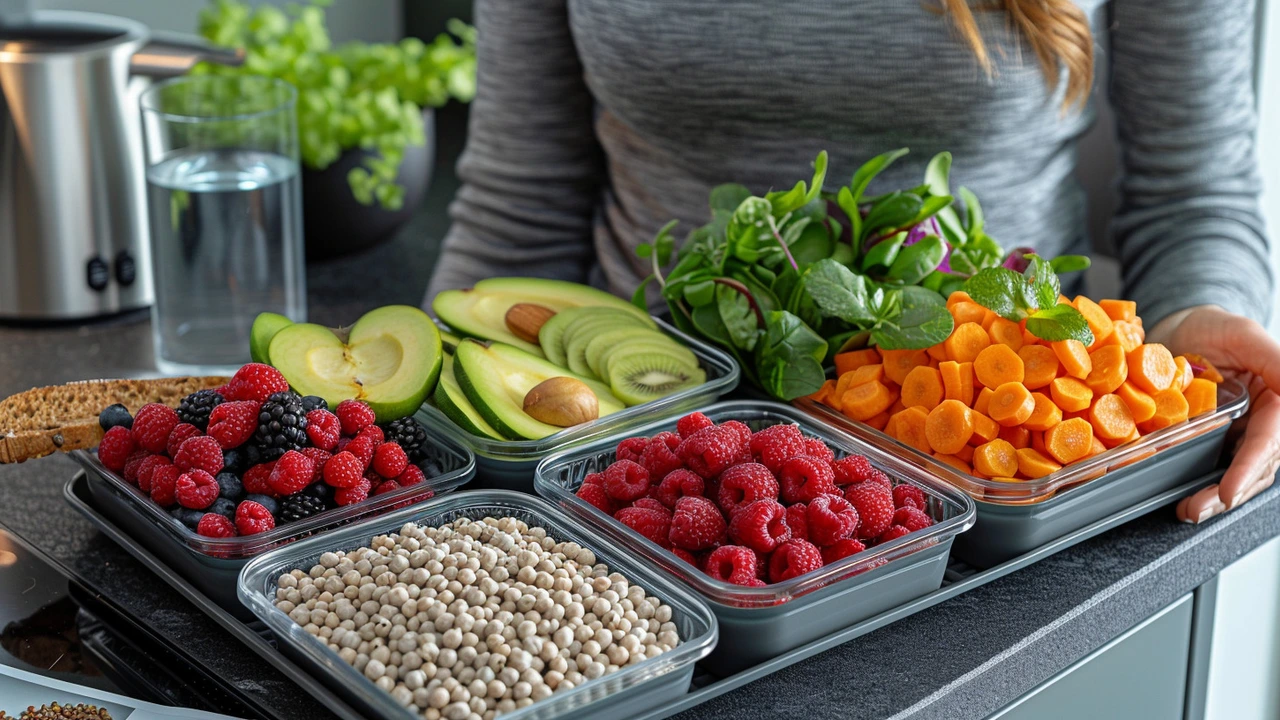Eating high-fiber foods can significantly impact your health in a positive way. From helping to maintain a healthy digestive system to aiding in weight management, dietary fiber is an essential component of a balanced diet.
Dietary fiber, found in plant-based foods, comes in two types: soluble and insoluble. Soluble fiber dissolves in water, forming a gel-like substance in the stomach, while insoluble fiber doesn't dissolve but adds bulk to the stool, helping food pass more quickly through the stomach and intestines.
Whether you're aiming to shed a few kilos or just want to ensure your digestive system works smoothly, integrating adequate fiber into your meals is key. We'll explore the various benefits, sources, and practical tips to make sure you get enough fiber each day.
- Understanding Dietary Fiber
- Benefits for Digestion
- Weight Management and Fiber
- Fiber-Rich Foods to Include
- Tips for Increasing Fiber Intake
Understanding Dietary Fiber
Dietary fiber is a crucial part of a balanced diet, and it's essential to know what it is and how it works. Found in plant foods, fiber is a type of carbohydrate that our bodies can't digest. Unlike other carbs that get broken down into sugars, fiber passes relatively intact through our stomach, intestines, and out of our system. The two main types of fiber are soluble and insoluble, each offering unique benefits.
Soluble fiber dissolves in water and turns into a gel-like substance during digestion. It helps lower blood cholesterol and glucose levels. This type of fiber is found in oats, peas, beans, apples, citrus fruits, carrots, barley, and psyllium. On the other hand, insoluble fiber promotes the movement of material through your digestive system and increases stool bulk, so it can be of benefit to those who struggle with constipation or irregular stools. Sources include whole-wheat flour, wheat bran, nuts, beans, and vegetables, such as cauliflower, green beans, and potatoes.
Fiber is not just about digestion. It plays a significant role in preventing chronic diseases. A high-fiber diet can help normalize bowel movements, lower cholesterol levels, control blood sugar levels, and aid in achieving a healthy weight. It may also help reduce the risk of cardiovascular disease, type 2 diabetes, and even some types of cancer. According to the Mayo Clinic, men should aim for 30-38 grams of fiber a day, while women should aim for 21-25 grams.
Incorporating fiber into your diet isn't as daunting as it may seem. Start by increasing the amounts of fruits, vegetables, legumes, and whole grains in your meals. Choose breakfast cereals that list whole grains as their first ingredient, like whole wheat or oats. Add beans to your soups and salads, and snack on fruits and nuts. Gradually increase your fiber intake to prevent gas, bloating, and cramps.
"Eating foods with fiber can yield many health benefits, including a reduced risk for heart disease, better weight management, and improved gut health," says Dr. Joanne Slavin, a professor of food science and nutrition at the University of Minnesota.
Remember, hydration is key when increasing fiber in your diet. Fiber works best when it absorbs water, so make sure to drink plenty each day. Eating a mix of different types of fiber, such as those found in fruits, vegetables, grains, and legumes, can help you get a range of benefits. Fiber may not be the most exciting part of diet discussions, but it's one of the most important for maintaining overall health and well-being.
Benefits for Digestion
High-fiber foods play a crucial role in promoting good digestive health. The way fiber works in the body helps keep our digestive system running smoothly. One of the main benefits of fiber is its ability to add bulk to the stool. Insoluble fiber doesn’t dissolve in water, so it passes through the digestive tract relatively intact. This helps food move through the stomach and intestines more quickly, preventing constipation, which is a common digestive issue many people face.
Beyond just preventing constipation, fiber can also help prevent or manage a few other digestive conditions. For instance, a diet high in fiber can reduce the risk of diverticulitis, an inflammation of the intestine. Diverticulitis can cause significant discomfort and lead to serious health complications if not managed properly. By encouraging regular bowel movements, fiber helps prevent this condition and promotes better digestive health overall.
Eating a high-fiber diet is also linked to a lower risk of developing hemorrhoids, which are swollen blood vessels in the rectum and anus. Hemorrhoids can be incredibly painful and lead to further health issues. By ensuring regular and softer stools, fiber reduces the strain on the lower digestive tract, minimizing the risk of hemorrhoid development.
According to the Mayo Clinic, "Fiber can also aid in achieving a healthy weight by helping you feel full longer. It adds bulk to your diet, so you feel full faster. With a healthier digestive system, your entire body function improves."
Soluble fiber, which dissolves in water to form a gel-like substance, plays a unique role in digestion. It slows down digestion, allowing for a more gradual absorption of nutrients. This slower process can be particularly beneficial for managing blood sugar levels, as it prevents spikes and crashes. For individuals with diabetes or those concerned about their blood sugar, integrating foods high in soluble fiber can be an essential part of managing their condition.
Additionally, fermentable fiber serves as a prebiotic, supporting the growth of beneficial bacteria in the gut. These bacteria, known as probiotics, play a critical role in maintaining a healthy gut microbiome. A balanced gut microbiome is essential for proper digestion, nutrient absorption, and overall immune function. Consuming high-fiber foods that act as prebiotics can therefore promote a healthy balance of gut bacteria.
It's important to note that while fiber offers numerous benefits, increasing fiber intake should be done gradually. A sudden increase can cause bloating and gas, as your digestive system needs time to adjust. Start by adding a small amount of fiber to your diet each day, and be sure to drink plenty of water. This helps the fiber work more effectively and can minimize any potential discomfort.
Incorporating a variety of high-fiber foods into your diet can ensure you reap all these digestive benefits. Fruits, vegetables, whole grains, legumes, nuts, and seeds are all excellent sources of dietary fiber. By choosing unprocessed, whole foods, you not only increase your fiber intake but also consume essential vitamins, minerals, and other nutrients that support overall health.

Weight Management and Fiber
One of the most remarkable benefits of a high-fiber diet is its ability to aid in weight management. Integrating fiber-rich foods into your daily meals can help you feel fuller for longer, which can reduce overall caloric intake. This happens because foods high in fiber typically require more chewing, which slows down your eating and gives your brain time to register that you are full. This natural regulation helps prevent overeating.
Moreover, fiber-rich foods tend to have a lower caloric density. This means you can consume larger portions without consuming too many calories. For instance, compare a small serving of chips to a large bowl of vegetables; the latter will bulk up your meal without loading on unnecessary calories. This helps you achieve a sense of satiety while still managing your calorie intake effectively.
Another benefit of fiber is its role in balancing blood sugar levels. Soluble fiber, in particular, slows the absorption of sugar, which can lead to more stable blood glucose levels. According to Dr. Joanne Slavin, a professor of food science and nutrition, "Including high-fiber foods in your diet can also help manage insulin levels, which is crucial for weight management and preventing type 2 diabetes."
Beyond these direct benefits, fiber indirectly influences weight by feeding beneficial bacteria in your gut. These bacteria produce short-chain fatty acids (SCFAs), which have been linked to reduced inflammation and a healthier metabolism. The gut-brain connection, which is mediated by these SCFAs, can also affect hunger hormones and satiety signals, further promoting healthy weight management.
If you're aiming to lose weight, consider incorporating more fiber-rich foods like whole grains, legumes, fruits, and vegetables into your diet. For instance, you could start your day with a bowl of oatmeal topped with fresh berries and a sprinkle of chia seeds. For lunch, a salad packed with beans, nuts, and a variety of colorful vegetables can be both satisfying and nutrient-dense.
Remember, though, to increase your fiber intake gradually. Sudden increases can lead to digestive discomfort like bloating or gas. It's also crucial to drink plenty of water, as fiber works best when it absorbs water. Aim for at least 25 to 30 grams of fiber per day, but be sure to listen to your body and adjust as needed.
Fiber-Rich Foods to Include
When it comes to adding more nutrients to your diet, high-fiber foods play a crucial role. They're not just essential for good digestion; they also help in maintaining a healthy weight and even controlling blood sugar levels. So, what are these fiber-rich foods that you should be including on your plate regularly?
First off, let's talk about fruits and vegetables. Fresh produce like apples, oranges, carrots, and broccoli are all excellent sources of dietary fiber. Apples, for example, contain about 4 grams of fiber each, both soluble and insoluble. This means they help not only in adding bulk to your stool but also in managing your cholesterol levels.
Grains are another big player in the high-fiber game. Whole grains like oats, barley, and brown rice are packed with dietary fiber. Oats are particularly rich in soluble fiber, which helps lower your cholesterol levels. Barley, on the other hand, offers a good mix of both soluble and insoluble fiber, making it a versatile grain to include in your diet.
Legumes and beans are often overlooked, but they shouldn't be. Foods like lentils, black beans, and chickpeas are some of the highest fiber foods you can eat. A cup of cooked lentils contains a whopping 15 grams of fiber, nearly half of the daily recommended intake. This makes them a perfect addition to soups, salads, or even as a meat substitute in various dishes.
"In terms of fiber content, beans are unparalleled," says Julieanna Hever, a plant-based dietitian. "They offer a high amount of both soluble and insoluble fiber, making them a powerhouse of nutrition."
Don't forget about nuts and seeds. Almonds, chia seeds, and flaxseeds also come loaded with dietary fiber. Chia seeds, for instance, expand when they absorb liquid, creating a gel-like texture that aids digestion. A single ounce of chia seeds can provide up to 10 grams of fiber, making them a perfect addition to smoothies or yogurts.
Including high-fiber foods in your diet doesn't have to be complicated. Mixing and matching these fiber-rich options can easily help you reach your daily fiber goals. For example:
- Start your day with a bowl of oatmeal topped with sliced fruits and a sprinkle of chia seeds.
- Incorporate more vegetables into your meals, like adding a side of steamed broccoli or a fresh garden salad.
- Opt for whole grains instead of refined grains. Choose brown rice over white rice or whole-grain bread instead of white bread.
- Snack on nuts and seeds instead of chips or cookies. A handful of almonds or a mix of seeds can be both filling and nutritious.
- Experiment with legumes in various dishes. Add lentils to your soups or use black beans in your salads.
By making these small adjustments, you can easily increase your fiber intake and enjoy the numerous health benefits that come with it. You'll find that high-fiber foods not only keep you feeling full and satisfied but also support a healthier, more balanced lifestyle.

Tips for Increasing Fiber Intake
Boosting your fiber intake doesn't have to be a chore. In fact, it can be both simple and delicious. The key is to make smart choices and small changes that add up over time.
Start your day with a high-fiber breakfast. Whole grains are a great way to nourish your body with fiber from the get-go. Consider swapping out your regular toast for whole grain bread or having a bowl of oatmeal topped with fresh fruits. These choices not only add fiber but also provide essential vitamins and minerals.
When it comes to snacks, reach for fruits, vegetables, and nuts. Fruits like apples, oranges, bananas, and berries are rich sources of dietary fiber. Carrots, cucumbers, and bell peppers are excellent veggie options that are easy to munch on throughout the day. Nuts such as almonds and walnuts are perfect fiber-packed snacks that also offer healthy fats.
Lentils, beans, and legumes are powerhouse foods packed with fiber. Adding them to soups, stews, and salads is an effortless way to boost your daily intake. Incorporate a variety of beans, such as black beans, chickpeas, and kidney beans, to keep your meals interesting and nutritionally balanced.
Switching up your standard pasta for whole grain or legume-based varieties can make a significant difference in your fiber consumption. Whole grain pasta and noodles made from lentils or chickpeas offer more fiber and protein than their white-flour counterparts. They're also an excellent way to maintain flavor while enhancing your diet's nutritional value.
Something as simple as adding seeds and nuts to your meals can also be a game-changer. Flaxseeds, chia seeds, and sunflower seeds can be sprinkled on yogurt, cereals, and salads. Not only do they add crunch and flavor, but they also pack a substantial fiber punch.
Don't forget about the power of vegetables. Making half of your plate consist of vegetables for each meal is a good rule of thumb. Leafy greens like spinach, kale, and broccoli are particularly high in fiber. Roasting, steaming, or stir-frying a variety of veggies each week can keep your meals diverse and delicious.
If you're baking, try incorporating whole grains into your recipes. Whole wheat flour, oat flour, and almond flour can be excellent substitutes for more refined products. This small change can make your baked goods healthier and more fibrous.
Gradually increasing your fiber intake is important to avoid digestive discomfort. Ensuring you drink plenty of water throughout the day will help your body handle the increased fiber smoothly. Fiber works best when it absorbs water, so staying hydrated is key to reaping all the benefits.
"Eating more foods that are high in fiber will make a tremendous difference in your overall health." – Mayo Clinic
Finding creative and tasty ways to incorporate higher fiber foods into your diet can be an enjoyable journey. Small adjustments here and there can lead to big health benefits, making you feel fuller longer, aiding digestion, and keeping your energy levels stable throughout the day.





